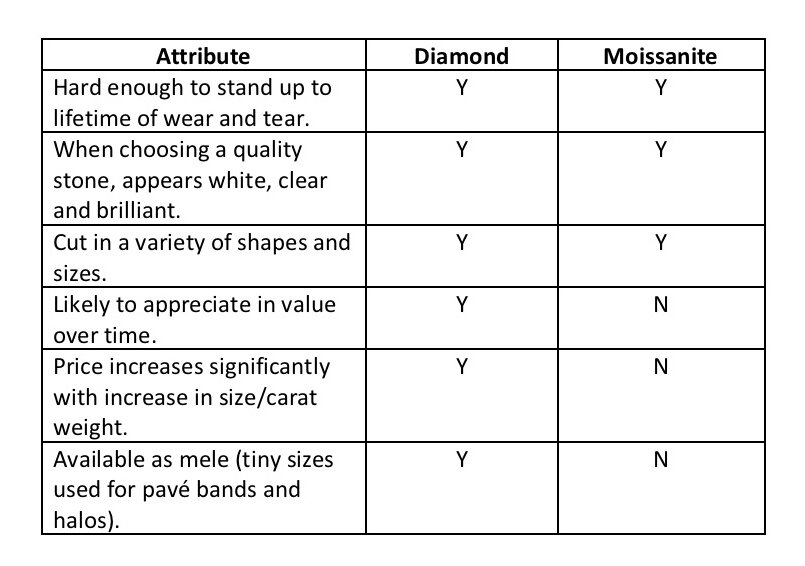Moissanite is a lab grown ‘silicon carbide’ (not to be confused with a lab grown diamond) that has gained notoriety for its remarkable resemblance to a diamond, both in its appearance and performance. Top quality moissanite can be near-colourless and free of visible inclusions – two desirable qualities in colourless gemstones.
Moissanite is double refractive. Light which enters the stone is split into two as it refracts outwards, creating brilliance and greater ‘fire’ than a diamond. On the Mohs scale of hardness, moissanite measures at 9.5 out of 10. Moissanite is very durable and suitable for everyday wear.
Moissanite was discovered as a naturally occurring gemstone by French scientist Henri Moissan in 1893. Naturally occurring moissanite fragments traveled to earth on meteors. Because natural moissanite crystals are very small, almost all moissanite used in modern jewellery is lab grown.
The exact process of creating of moissanite can vary from producer to producer, but they are generally made in very advanced laboratories using a combination of extreme heat and pressure. It can take two to three months to create a single stone.
As consumers have become more open minded about alternative gemstones for engagement rings and less focused on the status quo, moissanite has gained traction. Moissanite offers an affordable and beautiful alternative to a diamond without having to compromise on cut, colour or clarity. Moissanite prices don’t increase as drastically as diamonds when you raise the carat weight. Because of this, moissanite is a great option if you are have “champagne taste on a beer budget”
One of the most common questions clients have when selecting their centre stone is: what’s the difference between a moissanite and a diamond.
Here’s a breakdown of the main similarities and differences:

Like diamonds, moissanite are cut in a variety of shapes and sizes. More traditional shapes like round, oval and cushion are easier to come by, while fancy shapes like marquise, emerald or radiant cuts may need to be custom-cut. Unlike diamonds, moissanite is not made small enough to use for ‘mele’, small stones used in pave or halo designs.
It’s important to remember that moissanite and diamonds have different molecular weights. So a 1.00 ct. moissanite and a 1.00 ct. diamond would be different sizes. We recommend working from the ‘diamond equivalent’ carat weight, ensuring the dimensions of the moissanite in millimetres matches that of the diamond at your ideal carat weight.
One of the most attractive benefits of working with moissanite is the ability to maximize your budget with a large, diamond-like centre stone, without breaking the bank. If making an impact is your priority, give moissanite a closer look.
How much less expensive is moissanite than a diamond? Well, if you wanted a show stopping 2.00 ct. mined oval diamond solitaire ring, you’d be looking at a budget of $20,000-25,000+HST. A comparable moissanite ring would be closer to $3,800-4,500+HST – quite the difference!
Like most things, not all moissanite is created equal. Moissanite can be created with varying quality and standards. The original moissanite patent was created in 1998 by the American based innovator, Charles & Colvard, paving the way for moissanite production and standards. Charles & Colvard continue to maintain the highest reputation in the industry for its top quality Forever One moissanite. The patent has since expired, opening the market to many competitors who don’t always exhibit the same rigour as Charles & Colvard in production methods and grading. It’s important to ask your jeweller the origin of their moissanite to ensure a quality end product.